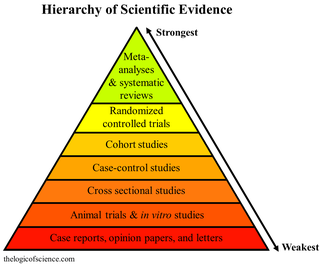Related Research Articles
Evidence-based medicine (EBM) is "the conscientious, explicit and judicious use of current best evidence in making decisions about the care of individual patients." The aim of EBM is to integrate the experience of the clinician, the values of the patient, and the best available scientific information to guide decision-making about clinical management. The term was originally used to describe an approach to teaching the practice of medicine and improving decisions by individual physicians about individual patients.
The conservation movement, also known as nature conservation, is a political, environmental, and social movement that seeks to manage and protect natural resources, including animal, fungus, and plant species as well as their habitat for the future. Conservationists are concerned with leaving the environment in a better state than the condition they found it in. Evidence-based conservation seeks to use high quality scientific evidence to make conservation efforts more effective.

Nature conservation is the moral philosophy and conservation movement focused on protecting species from extinction, maintaining and restoring habitats, enhancing ecosystem services, and protecting biological diversity. A range of values underlie conservation, which can be guided by biocentrism, anthropocentrism, ecocentrism, and sentientism, environmental ideologies that inform ecocultural practices and identities. There has recently been a movement towards evidence-based conservation which calls for greater use of scientific evidence to improve the effectiveness of conservation efforts. As of 2018 15% of land and 7.3% of the oceans were protected. Many environmentalists set a target of protecting 30% of land and marine territory by 2030. In 2021, 16.64% of land and 7.9% of the oceans were protected. The 2022 IPCC report on climate impacts and adaptation, underlines the need to conserve 30% to 50% of the Earth's land, freshwater and ocean areas – echoing the 30% goal of the U.N.'s Convention on Biodiversity. Ultimately, these movements should be further promoted to encourage biodiversity and to conserve a functional ecosystem.

Craniosacral therapy (CST) or cranial osteopathy is a form of alternative medicine that uses gentle touch to feel non-existent rhythmic movements of the skull's bones and supposedly adjust the immovable joints of the skull to achieve a therapeutic result. CST is a pseudoscience and its practice has been characterized as quackery. It is based on fundamental misconceptions about the anatomy and physiology of the human skull and is promoted as a cure-all for a variety of health conditions.
Adaptive management, also known as adaptive resource management or adaptive environmental assessment and management, is a structured, iterative process of robust decision making in the face of uncertainty, with an aim to reducing uncertainty over time via system monitoring. In this way, decision making simultaneously meets one or more resource management objectives and, either passively or actively, accrues information needed to improve future management. Adaptive management is a tool which should be used not only to change a system, but also to learn about the system. Because adaptive management is based on a learning process, it improves long-run management outcomes. The challenge in using the adaptive management approach lies in finding the correct balance between gaining knowledge to improve management in the future and achieving the best short-term outcome based on current knowledge. This approach has more recently been employed in implementing international development programs.
Evidence-based design (EBD) is the process of constructing a building or physical environment based on scientific research to achieve the best possible outcomes. Evidence-based design is especially important in evidence-based medicine, where research has shown that environment design can affect patient outcomes. It is also used in architecture, interior design, landscape architecture, facilities management, education, and urban planning. Evidence-based design is part of the larger movement towards evidence-based practices.

A systematic review is a scholarly synthesis of the evidence on a clearly presented topic using critical methods to identify, define and assess research on the topic. A systematic review extracts and interprets data from published studies on the topic, then analyzes, describes, critically appraises and summarizes interpretations into a refined evidence-based conclusion. For example, a systematic review of randomized controlled trials is a way of summarizing and implementing evidence-based medicine.
Evidence-based practice is the idea that occupational practices ought to be based on scientific evidence. While seemingly obviously desirable, the proposal has been controversial, with some arguing that results may not specialize to individuals as well as traditional practices. Evidence-based practices have been gaining ground since the formal introduction of evidence-based medicine in 1992 and have spread to the allied health professions, education, management, law, public policy, architecture, and other fields. In light of studies showing problems in scientific research, there is also a movement to apply evidence-based practices in scientific research itself. Research into the evidence-based practice of science is called metascience.
A hierarchy of evidence, comprising levels of evidence (LOEs), that is, evidence levels (ELs), is a heuristic used to rank the relative strength of results obtained from experimental research, especially medical research. There is broad agreement on the relative strength of large-scale, epidemiological studies. More than 80 different hierarchies have been proposed for assessing medical evidence. The design of the study and the endpoints measured affect the strength of the evidence. In clinical research, the best evidence for treatment efficacy is mainly from meta-analyses of randomized controlled trials (RCTs). Systematic reviews of completed, high-quality randomized controlled trials – such as those published by the Cochrane Collaboration – rank the same as systematic review of completed high-quality observational studies in regard to the study of side effects. Evidence hierarchies are often applied in evidence-based practices and are integral to evidence-based medicine (EBM).
CSIRO Publishing is an Australian-based science and technology publisher. It publishes books, journals and magazines across a range of scientific disciplines, including agriculture, chemistry, plant and animal sciences, natural history and environmental management. It also produces interactive learning modules for primary school students and provides writing workshops for researchers.

Natural resource management (NRM) is the management of natural resources such as land, water, soil, plants and animals, with a particular focus on how management affects the quality of life for both present and future generations (stewardship).
Health services research (HSR) became a burgeoning field in North America in the 1960s, when scientific information and policy deliberation began to coalesce. Sometimes also referred to as health systems research or health policy and systems research (HPSR), HSR is a multidisciplinary scientific field that examines how people get access to health care practitioners and health care services, how much care costs, and what happens to patients as a result of this care. HSR utilizes all qualitative and quantitative methods across the board to ask questions of the healthcare system. It focuses on performance, quality, effectiveness and efficiency of health care services as they relate to health problems of individuals and populations, as well as health care systems and addresses wide-ranging topics of structure, processes, and organization of health care services; their use and people's access to services; efficiency and effectiveness of health care services; the quality of healthcare services and its relationship to health status, and; the uses of medical knowledge.
Evidence-based nursing (EBN) is an approach to making quality decisions and providing nursing care based upon personal clinical expertise in combination with the most current, relevant research available on the topic. This approach is using evidence-based practice (EBP) as a foundation. EBN implements the most up to date methods of providing care, which have been proven through appraisal of high quality studies and statistically significant research findings. The goal of EBN is to improve the health and safety of patients while also providing care in a cost-effective manner to improve the outcomes for both the patient and the healthcare system. EBN is a process founded on the collection, interpretation, appraisal, and integration of valid, clinically significant, and applicable research. The evidence used to change practice or make a clinical decision can be separated into seven levels of evidence that differ in type of study and level of quality. To properly implement EBN, the knowledge of the nurse, the patient's preferences, and multiple studies of evidence must all be collaborated and utilized in order to produce an appropriate solution to the task at hand. These skills are taught in modern nursing education and also as a part of professional training.
Evidence-based dentistry (EBD) is the dental part of the more general movement toward evidence-based medicine and other evidence-based practices. The pervasive access to information on the internet includes different aspects of dentistry for both the dentists and patients. This has created a need to ensure that evidence referenced to are valid, reliable and of good quality.

Ecosystem health is a metaphor used to describe the condition of an ecosystem. Ecosystem condition can vary as a result of fire, flooding, drought, extinctions, invasive species, climate change, mining, fishing, farming or logging, chemical spills, and a host of other reasons. There is no universally accepted benchmark for a healthy ecosystem, rather the apparent health status of an ecosystem can vary depending upon which health metrics are employed in judging it and which societal aspirations are driving the assessment. Advocates of the health metaphor argue for its simplicity as a communication tool. "Policy-makers and the public need simple, understandable concepts like health." Some critics worry that ecosystem health, a "value-laden construct", can be "passed off as science to unsuspecting policy makers and the public." However, this term is often used in portraying the state of ecosystems worldwide and in conservation and management. For example, scientific journals and the UN often use the terms planetary and ecosystem health, such as the recent journal The Lancet Planetary Health.
The discipline of evidence-based toxicology (EBT) strives to transparently, consistently, and objectively assess available scientific evidence in order to answer questions in toxicology, the study of the adverse effects of chemical, physical, or biological agents on living organisms and the environment, including the prevention and amelioration of such effects. EBT has the potential to address concerns in the toxicological community about the limitations of current approaches to assessing the state of the science. These include concerns related to transparency in decision making, synthesis of different types of evidence, and the assessment of bias and credibility. Evidence-based toxicology has its roots in the larger movement towards evidence-based practices.

William James Sutherland is the Director of Research at the University of Cambridge Department of Zoology, and was previously the Miriam Rothschild Professor of Conservation Biology. He has been the president of the British Ecological Society. He has been a Fellow of St Catharine's College, Cambridge since 2008.

Participatory monitoring is the regular collection of measurements or other kinds of data (monitoring), usually of natural resources and biodiversity, undertaken by local residents of the monitored area, who rely on local natural resources and thus have more local knowledge of those resources. Those involved usually live in communities with considerable social cohesion, where they regularly cooperate on shared projects.
Horizon scanning (HS) or horizon scan is a method from futures studies, sometimes regarded as a part of foresight. It is the early detection and assessment of emerging technologies or threats for mainly policy makers in a domain of choice. Such domains include agriculture, environmental studies, health care, biosecurity, and food safety.
References
- ↑ "The Basics". Conservation Evidence. Retrieved 2015-03-07.
- 1 2 Sutherland, William J; Pullin, Andrew S.; Dolman, Paul M.; Knigh, Teri M. (June 2004). "The need for evidence-based conservation". Trends in Ecology and Evolution. 19 (6): 305–308. doi:10.1016/j.tree.2004.03.018. PMID 16701275.
- ↑ Sutherland, William J. (July 2003). "Evidence-based Conservation". Conservation in Practice. 4 (3): 39–42. doi:10.1111/j.1526-4629.2003.tb00068.x.
- 1 2 "Guidelines for Systematic Review and Evidence Synthesis in Environmental Management, Version4.2" (PDF). Collaboration for Environmental Evidence. March 2013. Archived from the original (PDF) on July 23, 2020. Retrieved March 1, 2015.
- ↑ Husk K, Lovell R, Cooper C, Stahl-Timmins W, Garside R (21 May 2016). "Participation in Environmental Enhancement and Conservation Activities for Health and Well-Being in Adults: A Review of Quantitative and Qualitative Evidence". Cochrane Database of Systematic Reviews. 2016 (5): CD010351. doi:10.1002/14651858.CD010351.pub2. PMC 6464867 . PMID 27207731.
{{cite journal}}: CS1 maint: multiple names: authors list (link) - 1 2 Dicks, L. V. (2014). "Organising evidence for environmental management decisions: a '4S' hierarchy". Trends in Ecology & Evolution. 29 (11): 607–613. doi: 10.1016/j.tree.2014.09.004 . PMID 25280588.
- ↑ Sutherland, W.J. 2000. The conservation handbook: research, management and policy. Oxford: Blackwell Scientific
- ↑ Pullin, A. S. and Knight, T. M. 2001. Effectiveness in Conservation Practice: Pointers from Medicine and Public Health. Conservation Biology, 15: 50–54
- ↑ "Environmental Evidence". www.environmentalevidence.org. Retrieved 2016-10-21.
- ↑ Young, K; et al. (2011). "Science and elephant management decisions in South Africa" (PDF). Biological Conservation. 144 (2): 876–885. doi:10.1016/j.biocon.2010.11.023. hdl: 2263/15750 .
- ↑ Pullin, A. S., and T. M. Knight. 2005. Assessing conservation management’s evidence base: a survey of management-plan compilers in the United Kingdom and Australia. Conservation Biology 19:1989–1996
- ↑ Cook, C. N., et al., 2010. Conservation in the dark? The information used to support management decisions. Frontiers in Ecology and the Environment 8:181–186.
- ↑ Adams, W. M. & Sandbrook, C. (2013) "Conservation, Evidence and Policy". Oryx, 47(3), 329–335


